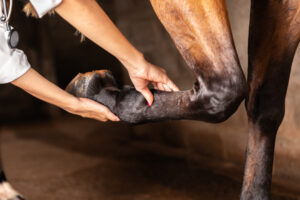With spring comes longer days, warmer weather, and crisp, fresh grass—an idyllic landscape for you and your horse. However, spring also brings more rain—a catalyst for an equally moist and muddy environment where horse scratches can easily develop.
Also known as mud fever, dew poisoning, and greasy heel, horse scratches are a common, yet painful skin condition that can make even the simple task of walking an uncomfortable experience for your equine friend.
If scratches are a problem for your horse, don’t worry. Our guide will teach you how to quickly and effectively treat scratches, as well as how to prevent future infections.
What Are Horse Scratches?
Equine Pastern Dermatitis is a condition where the skin between a horse’s heel and fetlock (or ankle) becomes inflamed. Any horse can be susceptible to scratches, although horses with longer fetlock hair, such as Draft horses or Friesians, are at a higher risk of developing this skin condition.1
This is because horse scratches are believed to be brought on by excessive wetting and drying of the fetlock area. Just like with human skin, repeated washing and drying of horse skin can cause it to become chapped and cracked. It’s through these tiny skin cracks that unwelcome bacteria and fungi are able to invade the horse and make a home for themselves leading to a painful fungal infection.
Longer fetlock hair not only retains moisture when it becomes wet, but it also blocks air from reaching the skin. The result? A damp, moist environment where bacteria and fungi can thrive and damage the affected area.
The Signs of Horse Scratches
Recognizing that your horse has developed scratches is the first step on your journey toward providing your equine friend some much-needed relief.
Signs of horse scratches will be localized to the back of the pastern, and can include:
- Swelling
- Redness
- Matted hair or hair loss
- Scabbed, flaky skin
- Crusty bumps
- Lesions
In some cases, a horse owner may mistake a horse scratch for horse ringworm. That’s why it is essential to be aware of the signs and symptoms so you can seek treatment as soon as possible.
In severe cases, scratches can spread and infect the front of the horse’s pastern as well.
Effectively Treating Scratches in Horses
Fortunately, with swift and thorough treatment, you can successfully clear up your horse’s painful scratches in as little as two weeks.2
Start by clipping the hair at the infected area. Not only will this allow you to better see and treat the problem, but it will also help the area breathe during the healing process.
Next, gently wash the area with an antibacterial or antifungal shampoo, such as Vetericyn’s FoamCare Equine Medicated Shampoo. A regular horse bath can help reduce bacteria and debris, and prevent horse pink eye, which is why grooming should be a regular part of your equine care routine. Because this shampoo is plant-based, you can trust that it won’t further irritate your horse’s skin with harsh chemicals. In fact, Vetericyn’s special formula not only cleans your horse’s skin, but it also works to enhance your horse’s natural defense against other dermatological conditions.
Let the shampoo sit on the skin for at least ten minutes.3 This will allow scabs to thoroughly soak so that they can be massaged off. Never attempt to scrape, pick, or scratch your horse’s scabs. This can cause the infection to move deeper into the skin, as well as open the door to secondary skin infections.
Once the area has been thoroughly washed, pat the skin dry or use a hairdryer on a low setting to ensure all moisture has been removed. Then, apply a topical treatment to the infected area. Vetericyn’s Antimicrobial All Animal Wound and Skin Care is a safe, non-toxic option to jumpstart your horse’s healing.
For best results, repeat this treatment once a day for seven to ten days. Then, you can reduce treatment to two to three times a week until scratches are no longer an issue for your horse.1
During the treatment process, it’s important to provide your horse with a clean, dry living environment to prevent any new bacteria from growing. This may mean replacing milled shavings in your horse’s stall with fluffy shavings that don’t contain as much moisture. You should also avoid walking your horse through any wet, muddy pastures.
To prevent bacteria and fungus from re-entering your horse’s skin, be sure to also thoroughly disinfect your horse’s hobbles, boots, and wraps.
If you find that your horse’s scratches don’t clear up with treatment, or if your horse is persistently developing scratches, contact your veterinarian. A thorough examination may be required to rule out other conditions, such as an underlying immune system disorder.
Preventing Horse Scratches
While treating scratches can get your horse back to galloping freely without the hindrance of painful scabs, preventing scratches can ensure your horse will never have to reign it in.
Here are some helpful tips for keeping your horse free of scratches:
- Maintain a clean, dry stall
- Use dry, non-chemically treated bedding
- Replace milled shavings with large, fluffy shavings
- Consider filling wet or muddy areas around gates with gravel
- Routinely implement horse hoof cleaning
- Thoroughly dry your horse’s legs after riding, especially if they have longer feathers
- Avoid turning your horse out at times when pastures may be wet or muddy, including early in the morning when frost and dew are more prevalent
- Regularly clip excess hair from your horse’s ankles to prevent moisture retention
- Routinely groom your horse with specially formulated shampoo
Ride On With Vetericyn
With a better understanding of horse scratches, and Vetericyn’s all-natural products, you can effectively treat this bothersome condition without compromising your horse’s health. Plus, Vetericyn’s medicated equine shampoo boosts your horse’s natural immune system, so you can feel confident that your horse is protected from future infections.
With Vetericyn, a little rain can’t keep you and your horse from experiencing all the joys spring has to offer.
 Reviewed by Dan Richardson, Veterinarian
Reviewed by Dan Richardson, Veterinarian
Dan Richardson has been a practicing veterinarian for over 10 years. He specializes in surgery and orthopedics. Dan is originally from rural western Nevada and attended the University of Idaho for undergraduate study and Oregon State University for Veterinary School. The Richardson Family enjoys camping and spending time on the water fishing, paddle boarding, or digging their feet in the sand somewhere warm.
Sources:
- Purdue University. Understanding and Treating Scratches in Horses. https://vet.purdue.edu/vth/large-animal/equine-health-tip-understanding-and-treating-scratches-in-horses.
- Equus. Quick and easy scratches relief. https://equusmagazine.com/diseases/quick-easy-scratches-relief-55228
- Equisearch. Scratches Treatment and Prevention. https://www.equisearch.com/discoverhorses/scratches-treatment-prevention-15905
- University of Minnesota Extension. Scratches: a skin problem in horses. https://extension.umn.edu/horse-health/scratches
- AAEP. Getting a Handle on Scratches. https://aaep.org/horsehealth/getting-handle-scratches

